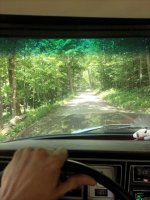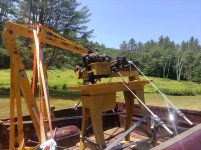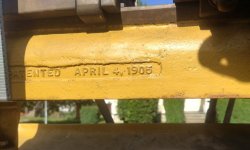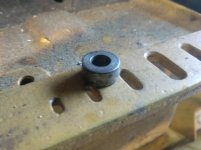FamilyTradition
Aluminum
- Joined
- Feb 24, 2018
- Location
- Greenfield, Mass
So I was browsing through Craigslist last week feeling out prices for machines, and I come across a listing for a "Brown and Sharpe Turret Lathe - $200" The story is, the owner's grandfather bought a machine shop in Brooklyn, NY about a hundred years ago, and for some reason, brought the machine up to Vermont, where it sat in a barn until some crazy SOB decided to go up there and pick it up.
That crazy SOB would be me. I couldn't pass up such a good deal, and I figured I didn't have enough junk sitting around the house already, so I arranged a time to pick it up, and made my way up to Plymouth, VT on a beautiful Saturday afternoon.
Of course everything I do has to be an interesting adventure, and this beautiful Saturday afternoon was also HOT. So I had to stop just before the exit in Westminster to let my truck cool down. She wasn't liking the constant uphill, and I probably need to do the water pump or radiator soon. I was able to get off the highway and into the town of Plymouth without overheating, but this is just where the fun begins.
For some godforsaken reason, this guy that bought the Brown and Sharpe No. 0 a hundred years ago, also lived in the middle of nowhere, and thought "Yeah, let's get the horse and buggy and haul this chunk of metal up the side of a mountain - great idea!". So I ventured down a few one lane dirt roads, got lost, GPS says there should be a road here, but it's just a precipitous drop down the valley into a river.

This picture wasn't even of the worst one, and doesn't do much justice to how tight my old boat was going down these roads (mind you, I don't have 4WD either, so I get real nervous on some of these VT backroads - I am just happy it is not mud season). A few near head-on collisions later (ain't it funny how much traffic there is in the middle of nowhere?), I make it up to the farm.
We make pleasantries and introductions, exchange money, and with the help of the previous owner's friends, we get it up into the bed of my truck (we took the tailstock off the machine and the machine off the base to do this and re-assembled for transport). I brought the engine crane with me just in case, so now it is just in the way along with bricks, boards, and the muffler, which fell off last week. Thankfully, I was smart enough to buy some brand new straps on the way up, so I got it all strapped in and ready to go fly South (that is, back home to Greenfield, Mass).

I took the state highways and US 5 back down without much incident, got a bite to eat in Brattleboro, and made it home. I had put in some OT this week so I was now tasked with doing all the clean-up around the homestead that I meant to do during the week.
The main obstacle then, was a Mercedes OM617 I pulled out of a parts car over the winter. It runs, but right now it's sort of a giant paperweight I am keeping around for parts (did I mention I liked to collect junk?). It was taking up most of the shed where this machine was destined to go. I got some organizing done, but those OM617's are heavy, even with the transmission disconnected.
Dad's tractor is over at my house, and the poor thing barely could make it budge. The engine crane was trapped in the back of my truck behind the machine. I was going to need it anyhow to assist removal from the bed of my truck - everyone was out on the boat this weekend, go figure. What the hell am I doing on a beautiful weekend in July moving cast iron around?

Anyhow, I was at least back at home in Greenfield. I called it a night at about 9PM after doing other preparations and attempting to move the gosh darned diesel engine. I did cover the old girl up to keep the dew off (I already brought the tailstock into the shed - at least one piece was inside!).
Sunday came with another unsuccessful attempt to pull that godforsaken engine out of the shed, using tractor hydraulic power, and I gave up for a few hours. I focused my energy on at least getting the machine down on ground level. The bucket came in handy here. Added some padding so there was no metal-on-metal, and used the engine hoist to get it into the bucket.

I didn't take too many pictures of getting the machine on the ground, as I am not any sort of expert at hoisting and rigging, and I am sure some would take offense to my methods. All I will say, is that I got the machine out of my truck without killing myself, damaging property, or (most importantly) hurting the machine.
I was finally able to get my nemesis, the OM617 diesel engine, moved. Of course, I did have to buy a chain hoist to help with that, but I am now the proud owner of a 5-ton chain hoist! It will come in handy on future projects.
Here's a few photos once I got the old girl in the shed and put (mostly) back together.



Here's the patent date when it was still strapped into the truck:

And some sort of bushing? spacer? that fell out when we loaded it into the truck. I have yet to figure out where it goes, and I have not ventured too far into the inner workings of the machine as of yet, as everything looks to be in place and (mostly) functional.

My plan is to do some minor clean up and then set up a few of the other machines I've collected over the years and run a shaft and pulleys. This lathe doesn't appear to have had much use, and with a little bit of clean up and some investment in tooling, I'm sure she will be making chips again.
Worst case scenario, it will sit in my shed for another hundred years, and my grandkids will sell it to a sucker with a pickup truck and $200 burning a hole in his pocket.
That crazy SOB would be me. I couldn't pass up such a good deal, and I figured I didn't have enough junk sitting around the house already, so I arranged a time to pick it up, and made my way up to Plymouth, VT on a beautiful Saturday afternoon.
Of course everything I do has to be an interesting adventure, and this beautiful Saturday afternoon was also HOT. So I had to stop just before the exit in Westminster to let my truck cool down. She wasn't liking the constant uphill, and I probably need to do the water pump or radiator soon. I was able to get off the highway and into the town of Plymouth without overheating, but this is just where the fun begins.
For some godforsaken reason, this guy that bought the Brown and Sharpe No. 0 a hundred years ago, also lived in the middle of nowhere, and thought "Yeah, let's get the horse and buggy and haul this chunk of metal up the side of a mountain - great idea!". So I ventured down a few one lane dirt roads, got lost, GPS says there should be a road here, but it's just a precipitous drop down the valley into a river.

This picture wasn't even of the worst one, and doesn't do much justice to how tight my old boat was going down these roads (mind you, I don't have 4WD either, so I get real nervous on some of these VT backroads - I am just happy it is not mud season). A few near head-on collisions later (ain't it funny how much traffic there is in the middle of nowhere?), I make it up to the farm.
We make pleasantries and introductions, exchange money, and with the help of the previous owner's friends, we get it up into the bed of my truck (we took the tailstock off the machine and the machine off the base to do this and re-assembled for transport). I brought the engine crane with me just in case, so now it is just in the way along with bricks, boards, and the muffler, which fell off last week. Thankfully, I was smart enough to buy some brand new straps on the way up, so I got it all strapped in and ready to go fly South (that is, back home to Greenfield, Mass).

I took the state highways and US 5 back down without much incident, got a bite to eat in Brattleboro, and made it home. I had put in some OT this week so I was now tasked with doing all the clean-up around the homestead that I meant to do during the week.
The main obstacle then, was a Mercedes OM617 I pulled out of a parts car over the winter. It runs, but right now it's sort of a giant paperweight I am keeping around for parts (did I mention I liked to collect junk?). It was taking up most of the shed where this machine was destined to go. I got some organizing done, but those OM617's are heavy, even with the transmission disconnected.
Dad's tractor is over at my house, and the poor thing barely could make it budge. The engine crane was trapped in the back of my truck behind the machine. I was going to need it anyhow to assist removal from the bed of my truck - everyone was out on the boat this weekend, go figure. What the hell am I doing on a beautiful weekend in July moving cast iron around?

Anyhow, I was at least back at home in Greenfield. I called it a night at about 9PM after doing other preparations and attempting to move the gosh darned diesel engine. I did cover the old girl up to keep the dew off (I already brought the tailstock into the shed - at least one piece was inside!).
Sunday came with another unsuccessful attempt to pull that godforsaken engine out of the shed, using tractor hydraulic power, and I gave up for a few hours. I focused my energy on at least getting the machine down on ground level. The bucket came in handy here. Added some padding so there was no metal-on-metal, and used the engine hoist to get it into the bucket.

I didn't take too many pictures of getting the machine on the ground, as I am not any sort of expert at hoisting and rigging, and I am sure some would take offense to my methods. All I will say, is that I got the machine out of my truck without killing myself, damaging property, or (most importantly) hurting the machine.
I was finally able to get my nemesis, the OM617 diesel engine, moved. Of course, I did have to buy a chain hoist to help with that, but I am now the proud owner of a 5-ton chain hoist! It will come in handy on future projects.
Here's a few photos once I got the old girl in the shed and put (mostly) back together.



Here's the patent date when it was still strapped into the truck:

And some sort of bushing? spacer? that fell out when we loaded it into the truck. I have yet to figure out where it goes, and I have not ventured too far into the inner workings of the machine as of yet, as everything looks to be in place and (mostly) functional.

My plan is to do some minor clean up and then set up a few of the other machines I've collected over the years and run a shaft and pulleys. This lathe doesn't appear to have had much use, and with a little bit of clean up and some investment in tooling, I'm sure she will be making chips again.
Worst case scenario, it will sit in my shed for another hundred years, and my grandkids will sell it to a sucker with a pickup truck and $200 burning a hole in his pocket.



